Book contents
- Frontmatter
- Contents
- List of contributors
- Preface
- I Comparative and functional fungal genomics
- 1 Genome and proteome analysis of industrial fungi
- 2 The rice blast story: from genome sequence to function
- II Bioactive molecules
- III Protein folding and secretion
- IV Fungal bioremediation
- V Fungal biocontrol of pests
- Index
- References
2 - The rice blast story: from genome sequence to function
from I - Comparative and functional fungal genomics
Published online by Cambridge University Press: 05 October 2013
- Frontmatter
- Contents
- List of contributors
- Preface
- I Comparative and functional fungal genomics
- 1 Genome and proteome analysis of industrial fungi
- 2 The rice blast story: from genome sequence to function
- II Bioactive molecules
- III Protein folding and secretion
- IV Fungal bioremediation
- V Fungal biocontrol of pests
- Index
- References
Summary
Introduction
Rice blast disease, caused by the filamentous fungus Magnaporthe grisea, is a serious and recurrent problem in all rice-growing regions of the world (Talbot, 2003; Valent & Chumley, 1991). It is estimated that each year enough rice is destroyed by rice blast disease to feed 60 million people. Control of this disease is difficult; new host-specific forms develop quickly to overcome host resistance and chemical control is typically not cost effective (Ou, 1987). Infections occur when fungal spores land and attach themselves to leaves using a special adhesive released from the tip of each spore (Hamer et al., 1988). The germinating spore develops an appressorium, a specialized infection cell, which generates enormous turgor pressure – up to 8 MPa – that ruptures the leaf cuticle allowing invasion of the underlying leaf tissue (de Jong et al., 1997; Dean, 1997). Subsequent colonization of the leaf produces disease lesions from which the fungus sporulates and spreads to new plants. When rice blast infects young rice seedlings, whole plants often die, while spread of the disease to the stems, nodes or panicle of older plants results in nearly total loss of the rice grain. Recent reports have further shown that the fungus has the capacity to infect plant roots (Sesma & Osbourn, 2004). Different host-limited forms of Magnaporthe also infect a broad range of grass species including wheat, barley and millet.
- Type
- Chapter
- Information
- Exploitation of Fungi , pp. 10 - 22Publisher: Cambridge University PressPrint publication year: 2007



